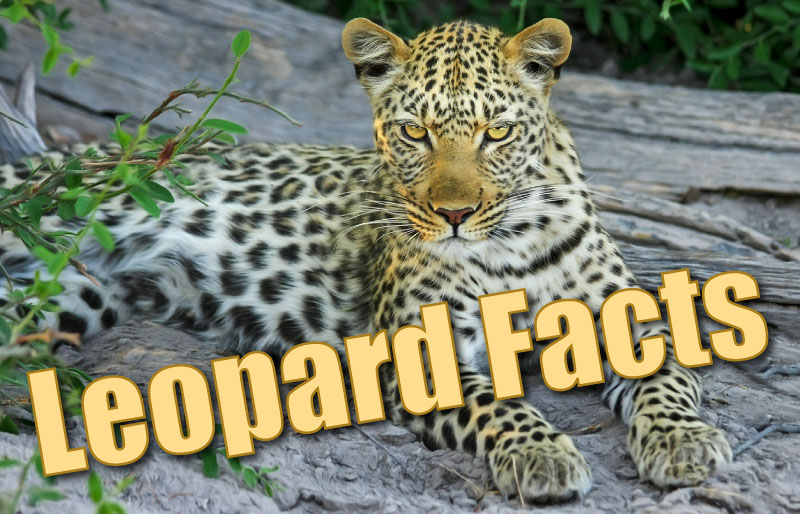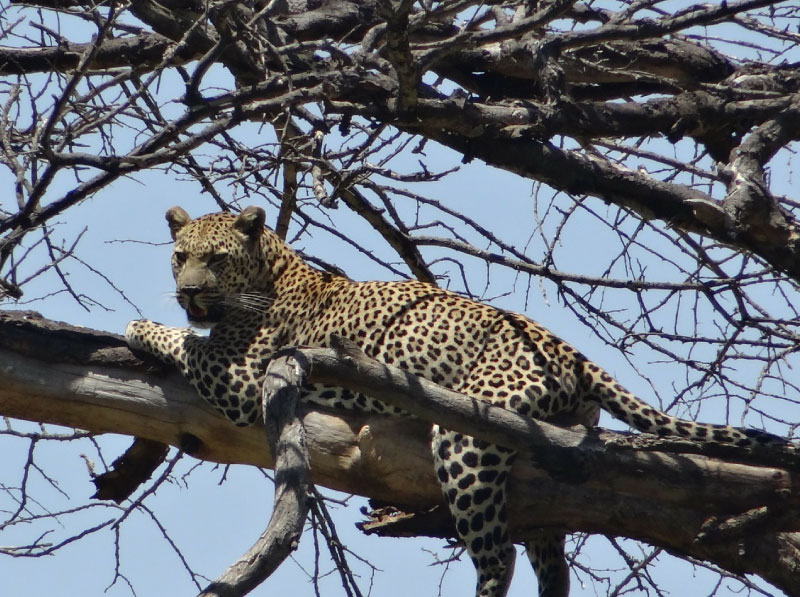Leopard facts for kids, students and adults. The leopard is a supreme hunter, known not only for its speed and power, but also for its stealth. In this article we'll take an in-depth look at this beautiful big cat.
Scientific Stuff
The leopard is a member of the cat family, Felidae. This family is split into two subfamilies: Pantherinae and Felinae. The leopard is a member of the Pantherinae subfamily.
Are Leopards 'Big Cats'?
The leopard is a member of the genus Panthera, which also includes the lion, tiger, jaguar and snow leopard. This group of animals is also informally known as the 'big cats'.
The leopard is the second-smallest of the big cats; only the snow leopard is smaller.
The leopard's scientific name is 'Panthera pardus'.
Where Do Leopards Live?
Leopards are found in Northeast Africa, Sub-Saharan Africa, Central Asia, China and India. Outside of Africa, their populations are endangered.
What do leopards look like?
Leopards are muscular and sleek. Their fur is tan with a distinct rosette pattern. Their undersides are cream or white.
How big are leopards?
Leopards average 4.25 - 6.25 feet long. They weigh 66 - 170 pounds. Don’t let their size fool you, these stealthy predators are pure muscle!
How strong are leopards?
Leopards are extremely strong. Pound for pound, they are the stronger than lions, tigers and jaguars. They are able to lug large prey high into the trees to keep them safe from scavengers ( animals that eat prey that is already dead) like hyenas.
From high in the trees leopards can spot and pounce on prey undetected, a skill that takes a tremendous amount of strength.
Do leopards live alone or in groups?
Leopards live alone, except to mate or when a female has young. Leopards are very protective of their territory. They urinate on trees and brush to mark their area. They also claw trees to keep other leopards away.
What do leopards eat?
Leopards are carnivores (meat eaters). They are excellent hunters. Leopards are nocturnal (active at night). Deer, antelope and wild hogs are no match for these sneaky cats.
Leopards' colouring allows them to stalk prey and wait for the perfect moment to pounce. Even gorillas are no match for them, leopards are the only known natural predator known to gorillas.
The video below shows just how a leopard hunts its prey.
https://www.youtube.com/watch?v=-XC6r9SIQfo
Leopards are agile swimmers, which means that crabs and other aquatic animals are on their menu. One scientist observed a leopard kill and eat a baboon, then notice it had a baby along. The leopard took the baby baboon up into the trees and groomed and nurtured it just like one of its own!
Are leopards dangerous to humans?
Occasionally, leopards attack humans, as well as pets and livestock. As populations increase and people begin to live closer and closer to the leopards natural habitat these attacks have increased.
Leopards are simply protecting their territory and hunting for food, which is natural for animals. We can limit these attacks by stopping deforestation and protecting the natural habitats of wild animals.
Leopard Facts For Kids
- Leopards purr when they are content and growl when they are upset, just like domestic cats. They also cough to announce their presence to other leopards.
- Leopards can run at a speed of 36 miles per hour. They can leap 9 feet vertically, and six feet horizontally.
- Cubs stay with their mother for almost two years, only half of the cubs that are born will make it to adulthood.
- The only real predators leopards have are humans. Leopards are prized for their fur. Some leopards are sold in the exotic animal market for thousands of dollars. Some people feel that there are healing qualities in leopard whiskers and bones, and leopards are hunted for that purpose too.
- In Asia and Africa, black leopards are called panthers. It is hard to see the rosette markings on black fur, so they are seen by most as being all black. When they are adults, the spots fade and the animals are all black.
- Male leopards are called leopards. Female leopards are called leopardesses.
- The leopard’s spots are circular in Eastern Africa, and square in Southern Africa.
- Leopards use white spots on the tips of their tails to communicate with other leopards in tall grass. They also have spots on the backs of their ears that do the same thing.
- A leopard’s tail is almost as long as its body. They use their long tails to balance.
- Leopards lift their tails to show the white or cream colored underside when they are not hunting as a sign to other animals that the coast is clear, at least for now.
- Female leopards give up their roaming when their young are small. The babies are a brownish black color to keep them protected from predators.
- Leopards are shy. Even in wildlife preserves, there is no guarantee you will be able to “ spot” one of these elusive cats.
Leopard Activities
1. A legend is a traditional story that is used to explain something that was often unexplainable by people in the past. These stories were passed down from generation to generation. Even now, people still enjoy listening to the stories.
There are a lot of legends about how the leopard got its spots. Put on your thinking cap and write your own legend to explain how the leopard got its spots. It doesn’t have to be realistic, get creative. Draw an illustration for your legend and share it with someone.
2. Compare the leopard, lion, tiger and jaguar. Make a chart or graph to show your findings. Which is the biggest? Which is the strongest? Which ones are endangered and which are not? Compare any facts you’d like. Present your findings to your parents.
3. get involved in fundraising for a charity such as Big Cat Rescue.
Discover More with Active Wild
You can discover more amazing rainforest animals on this page: Rainforest Animals List with Pictures & Facts





